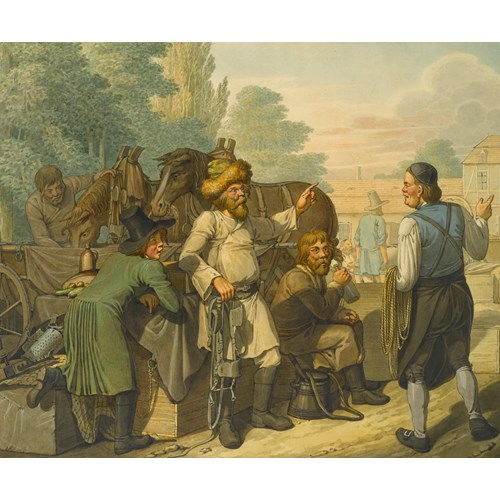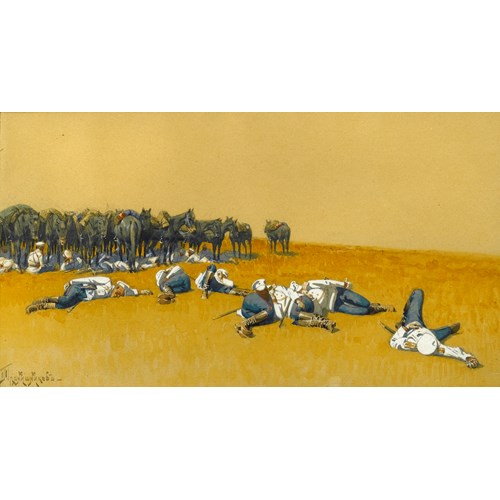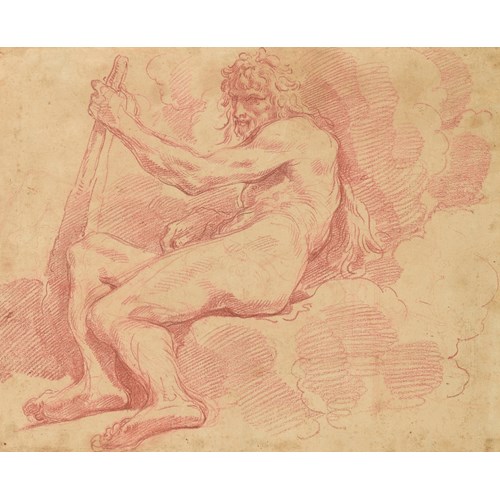Bartolommeo Traballesi
Portrait of a Lady, possibly the Poet Maddalena Salvetti (1557-1610), in a Green Dress and Pearls, Standing at a Draped Table, with a Pet Squirrel
Period 1400-1600, 16th Century
Origin Italy
Medium Oil on panel
Dimension 97.2 x 73.7 cm (38¹/₄ x 29 inches)
It is likely that this portrait was commissioned to celebrate the marriage in 1572 of Maddalena Salvetti to Zanobi Acciaiolli (1548-1613), a commander in the Order of Saint Stephen - a dynastic military order founded in 1561 by Cosimo I de’ Medici (1519-1574). In its early years, the Order successfully took part in the Spanish wars against the Ottomans, being present at the siege of Malta (1565), the Battle of Lepanto (1571) and the capture of Annaba in Algeria.
The Acciaioli were a prominent Florentine banking family (Compagna di Ser Leone degli Acciaioli e de’ suoi consorti) whose business spread from Greece to Western Europe. During the mid-fourteenth century Bishop Angiolo Acciaioli (1298-1357) briefly ruled Florence and subsequently from about 1390 until 1460, the family ruled the Duchy of Athens, maintaining close ties with the younger branch of the Medici through the marriage of Laudomia Acciaioli to Pierfrancesco de’ Medici (1430-1436).
Maddalena Salvetti was the daughter of Salvetto di Niccolò Salvetti and a poet of numerous works including Il David perseguitato o vero fuggitivo (published in 1611 just after her death), which was dedicated to the Archduchess Marie-Maddalena of Austria (1589-1631). She also wrote a collection of 158 sonnets and poems for Ferdinand I de’ Medici, Grand Duke of Tuscany (1549-1609) entitled Rime toscane in lode del Serenissimo don Ferdinando Medici terzo Gran Duca di Toscana. The publication was designed to celebrate his marriage to Christine of Lorraine in 1589.
In the present work, Maddalena Salvetti is depicted wearing a sumptuous green gown with a yellow underskirt. Her cream and gold lined chemise is dappled with an almost ostrich skin pattern and the lace detailing on her cuff is exquisitely wrought by Traballesi. The lace is repeated once more around her collar where wispy lengths of thread hang as a series of necklaces. Along the neckline of her chemise, a series of elaborate buttons are meticulously painted. This attention to detail is again seen on her shoulders where decorative acorns line the edge. She wears a simple double-strand pearl necklace with a single pearl droplet, a pair of triangular bobbin earrings and her hair is prettily tied up with white ribbons.
The sitter’s pose is quietly confident and poised as she gazes unswervingly out at the viewer. Portraiture in the sixteenth century advanced beyond the formal conventions introduced in the quattrocento and began to explore a range of different poses other than the traditional profile as sitters began to interact more intimately and directly with the viewer.
As a published poet Maddalena Salvetti would have had, to some degree, a level of artistic and social independence which the viewer can sense here in her sure pose. She coolly rests her left hand against her hip and with her right she pets her black squirrel as it sits on a red draped table, wearing a red and silver bell lined collar.² Unusual domesticated pets, such as squirrels, were not uncommon during the Renaissance and were particularly popular companions for elegant ladies, who usually adorned them with collars decorated with bells.³
Now reattributed to Bartolommeo Traballesi, this portrait marks a seminal contribution to his existing body of work and a rare portrait. Until recently there had been limited scholarship on, and research into, Traballesi’s career but thanks to Simona Lecchini Giovannoni and A. Nesi there has been a revival of interest in the Florentine master. Although little is known about his personal circumstances, it seems that he was a pupil of Michele Tosini (1503-1577) and his brother, Francesco, was also an artist. Furthermore, his contribution to the decoration of the studiolo of Francesco I in the Palazzo della Signoria (completed 1570-1572) may suggest that he was also a pupil of Giorgio Vasari (1511-1574) who supervised the project. For the studiolo, Traballesi painted his dramatic interpretation of the Greek mythological story of Danaë’s impregnation by Zeus who comes to her in the form of golden rain.⁴
Vasari employed some of the best Florentine artists to contribute to the pictorial decoration of the studiolo - including Alessandro Allori (1535-1607), Maso da San Friano (1536-1571) and Santi di Tito (1536-c.1602) as well as Vasari himself. Such a commission would have been hugely prestigious for the young Traballesi.
Undoubtedly Portrait of a Lady, possibly the Poet Maddalena Salvetti was painted by Traballesi in the sixteenth century Florentine tradition of portraiture led by Agnolo Bronzino (1503-1572) as well as by fellow Mannerists, Francesco Salviati (1510-1563), Jacopo Pontormo (1494-1557) and Rosso Fiornentino (1494-1540). Individual portraits, as opposed to donor portraits, had become increasingly popular from the fifteenth century as the wealthy elites sought to have their likeness, or that of family members, nobly captured.
Bronzino was perhaps the most celebrated and skilled portraitist of the sixteenth-century and established the norm for portraiture in granducal Medicean Florence. The earlier attribution in 1901 to Bronzino of Portrait of a Lady, possibly the Poet Maddalena Salvetti attests to his reputation for conveying aristocratic dignity. As nominated court painter to Duke Cosimo (1519-1574) he, along with his studio, produced numerous portraits of the Duke, his wife Eleanor of Toledo (1522-1562) and their eight children. As well as Medici patronage, Bronzino also completed portraits of other sitters that exemplified the courtly style of portraiture he had created. These portrait figures - often perceived as static, elegant, and stylish exemplars of unemotional haughtiness and self-assurance - influenced the course of European court portraiture for a century.
Bronzino’s Mannerist approach to portraiture was utilised by his contemporaries, including Traballesi’s teacher Michele Tosini. A notable portraitist, Tosini also assisted Vasari with the decoration of the Salone dei Cinquecento in the Palazzo Vecchio. A lovely portrait of an unknown woman, now in the Metropolitan Museum of Art, New York, thought to be by Tosini can be compared to Traballesi’s Portrait of a Lady, possibly the Poet Maddalena Salvetti. Here the sitter is similarly dressed in aristocratic attire and looks at viewer with a knowing elegance and air of self-confidence.
As a pupil of Bronzino and a fellow contributor to the studiolo, Traballesi would also have been aware of the work of Alessandro Allori.⁵ In the 1560s, Allori was commissioned to complete a portrait of Eleanor of Toledo, Grand Duchess of Tuscany, and the resulting painting epitomises the fashion for sixteenth century portraiture in Florence. As in this portrait of Maddalena Salvetti, Eleanor of Toledo is shown in all her sartorial elegance; the detailing on her bodice and chemise is particularly tactile while her hair is simply, though elegantly, fashioned. One can perhaps assume that artists such as Traballesi relished the opportunity to capture in exacting detail the dignified modishness of such Florentine noble women.
We are grateful to Lisa Goldenberg Stoppato for proposing the attribution to Traballesi in private correspondence with the previous owner (October 2008) and suggesting that the sitter might be Maddalena Salvetti (1557-1610), daughter of Salvetto di Niccolò Salvetti and wife of Zanobi di Acciaiuolo Acciaiolli.
¹ Other works by Traballesi can be found in the Florentine churches of the Ognissanti and Santissima Annunziata.
² The jaunty pose of Maddalena Salvetti makes passing reference to the confident, somewhat arrogant, pose seen in Bronzino’s Portrait of a Young Man with a Book, 1535-1540, Metropolitan Museum of Art, New York.
³ For similar examples of ladies with domesticated pets in portraiture see Hans Holbein the Younger, A Lady with a Squirrel and a Starling (Anne Lovell?), c.1526-1528, The National Gallery, London and Leonardo da Vinci, Lady with an Ermine, c.1489-1490, Czartoryski Museum, Kraków.
⁴ For further discussion see Corinne Mandel, “Santi di Tito’s Creation of Amber in Francesco I’s Scrittoio: A Swan Song for Lucrezia de’ Medici”, The Sixteenth Century Journal, Vol. 31, No. 3 (Autumn, 2000), fig. 4, p. 728.
⁵ At the time of his death Bronzino was living in the Allori family house in Florence.
Period: 1400-1600, 16th Century
Origin: Italy
Medium: Oil on panel
Signature: The reverse branded with the mark ‘A•A’.
Dimension: 97.2 x 73.7 cm (38¹/₄ x 29 inches)
Provenance: with G. Donaldson, Renaissance Galleries, 104 New Bond Street; Christie's, London, 9 July 1901, lot 45, as 'Bronzino'.
Anonymous sale; Henri Baudoin, Paris, 24 June 1922, as 'School of Bronzino'.
Anonymous sale; Sotheby's, New York, 11 January 1996, lot 51, as 'Tommaso Manzuoli, Portrait of an elegant woman said to be Maddalena Acciaiolli'.
More artworks from the Gallery


, in a Green Dress and Pearls, Standing at a Draped _T638990626119457264.jpg?width=2000&height=2000&mode=max&scale=both&qlt=90)






